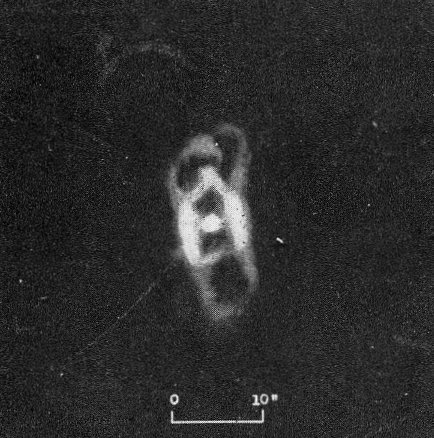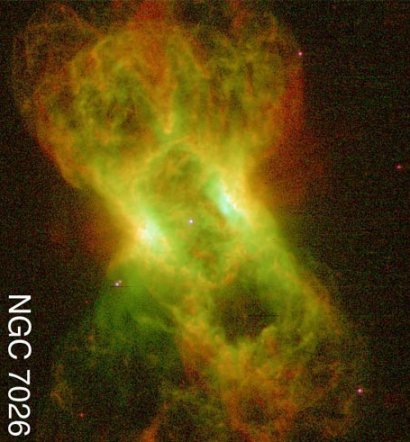NGC 7026
From Curtis: "Very irregular; there are two bright lobes...A bridge
of nebulosity connects these and involves the central star so that
it resembles the letter H...Irregular wisps extend from each
end...Fairly bright." NGC 7026, not to be confused with better-
known and nearby NGC 7027, lies within the
heart of the Milky Way in northern Cygnus five degrees northeast of Deneb, just a third of a degree north-
northwest of 63 Cygni (which makes a good guide star), and five and
a half degrees almost due north of brighter NGC 7027. As a result
of location and distance, NGC 7026 is dimmed visually by about a
magnitude and a half by interstellar
dust. The Hubble image at right (which should be rotated
slightly clockwise to align the two) matches nicely with Curtis's
century-old composite drawing, but reveals a more complex structure
with an interior bipolar structure surrounded by a four-lobed, even
conical, appearance. Explaining such forms is a daunting task, and
might be related to binarity (though there is no evidence for it),
magnetic fields, rotation, and who knows what else?
The distance as usual is uncertain. An average of various
estimates with a measure from the amount of intervening dust
suggests around 5900 light years. As seen in both pictures, no
single angular diameter can describe the nebula with its great
elongation and delicate outer wisps. Curtis's dimensions of 10 X
25 seconds of arc gives 0.3 X 0.7 light years. The nebula is
expanding at a rate of 40 to 50 kilometers per second. There is no
evidence for any particular abundance enhancements. The helium
content relative to hydrogen is normal. While raised above the
solar ratios, there if nothing unusual about the carbon/oxygen and
nitrogen/oxygen ratios, both of which are well less than 1.
Curtis estimated the central star's magnitude at 14. Modern
measures give visual magnitudes of 14.2 to 15.1. Adopting 14.2
combined with the brightness of the nebular hydrogen and helium emission lines gives a central star
temperature of 80,000 Kelvin, a luminosity of 2100 times that of
the Sun, a core mass of 0.56 solar, and shows the core (the nascent
white dwarf) to be in a
heating phase at constant luminosity. The parent star should then
have had a mass of just over 1.1 times that of the Sun, which is
consistent with the un-enriched nebular chemical composition,
enrichment falling in the domain of higher mass stars.
Left: Image and quote by H. D. Curtis from Publications of the Lick
Observatory, Volume 13, Part III, 1918. Right: Hubble Legacy
Archive, A. Hajian et al.



